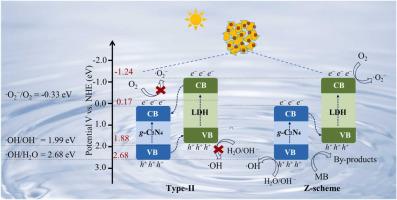利用氧空位工程设计 MgAlTi-LDH/g-C3N4 的二维/二维异质结,增强其在自然光下的光催化活性
IF 7.2
2区 工程技术
Q1 ENGINEERING, CHEMICAL
引用次数: 0
摘要
半导体光催化是一种理想的废水处理方法。然而,光生电子-空穴对的快速重组限制了光催化效率的提高。利用不同能带匹配的半导体构建异质结构和表面缺陷工程被认为是抑制光生电子-空穴对重组的有效策略。本文首次通过在超薄氯化萘纳米片上生长富氧空位的 MgAlTi-LDH 制备了新型 MgAlTi-LDH/-CN 异质结,用于在自然光下降解亚甲基蓝(MB)。随后,通过 XRD、FT-IR、UV-vis DRS、TEM、BET 和 XPS 对制备材料的光吸收特性、晶相、微观结构和形态分析进行了表征。由于掺杂了钛,富氧空位的 MgAlTi-LDH 在降解甲基溴方面表现出更高的光催化活性,是 MgAl-LDH 的 5.5 倍。此外,MgAlTi-LDH/CN 异质结构在可见光照射下表现出更高的光催化活性,分别是 MgAl-LDH、MgAlTi-LDH 和 -CN 的 5.9 倍、4.9 倍和 3.2 倍。在自然光照射下,MgAlTi-LDH/-CN 可在 130 分钟后降解 95% 的甲基溴。MgAlTi-LDH/-CN 光催化活性的提高归因于 MgAlTi-LDH 和 -CN、表面氧空位以及异质结构界面的协同作用。这项研究为通过构建具有表面缺陷的异质结来合成高效光催化剂以去除废水中的有机污染物提供了一种新策略。本文章由计算机程序翻译,如有差异,请以英文原文为准。

2D/2D heterojunction of MgAlTi-LDH/g-C3N4 with oxygen vacancy engineering for enhanced photocatalytic activities under natural sunlight
Semiconductor photocatalysis is an ideal method for wastewater treatment. However, the rapid recombination of photogenerated electron-hole pairs limits the improvement of photocatalytic efficiency. Constructing heterostructures by different energy band-matched semiconductors and surface defect engineering are considered as effective strategies to inhibit the recombination of photogenerated electron-hole pairs. Herein, a novel MgAlTi-LDH/-CN heterojunction was fabricated by growth of oxygen vacancy rich MgAlTi-LDH on ultrathin -CN nanosheets first time for the degradation of methylene blue (MB) under natural sunlight. The optical absorption properties, crystalline phase, microstructure, and morphological analysis of the fabricated materials are subsequently characterized by XRD, FT-IR, UV–vis DRS, TEM, BET and XPS. Owing to Ti-doping, oxygen vacancy rich MgAlTi-LDH exhibited superior photocatalytic activity for MB degradation, which was 5.5 times of that of MgAl-LDH. Furthermore, MgAlTi-LDH/-CN heterostructures showed a higher photocatalytic activity under visible light irradiation, which was 5.9, 4.9, and 3.2 times of that of MgAl-LDH, MgAlTi-LDH and -CN, respectively. Upon natural sunlight irradiation, MgAlTi-LDH/-CN can degrade 95 % of MB after 130 min of irradiation. The improvement of photocatalytic activity of MgAlTi-LDH/-CN was attributed to the synergistic effect of MgAlTi-LDH and -CN, surface oxygen vacancies, and heterostructure interface. This work promotes a new strategy to synthesize high-efficiency photocatalysts for the removal of organic pollutants from wastewater by constructing heterojunctions with surface defects.
求助全文
通过发布文献求助,成功后即可免费获取论文全文。
去求助
来源期刊

Journal of Environmental Chemical Engineering
Environmental Science-Pollution
CiteScore
11.40
自引率
6.50%
发文量
2017
审稿时长
27 days
期刊介绍:
The Journal of Environmental Chemical Engineering (JECE) serves as a platform for the dissemination of original and innovative research focusing on the advancement of environmentally-friendly, sustainable technologies. JECE emphasizes the transition towards a carbon-neutral circular economy and a self-sufficient bio-based economy. Topics covered include soil, water, wastewater, and air decontamination; pollution monitoring, prevention, and control; advanced analytics, sensors, impact and risk assessment methodologies in environmental chemical engineering; resource recovery (water, nutrients, materials, energy); industrial ecology; valorization of waste streams; waste management (including e-waste); climate-water-energy-food nexus; novel materials for environmental, chemical, and energy applications; sustainability and environmental safety; water digitalization, water data science, and machine learning; process integration and intensification; recent developments in green chemistry for synthesis, catalysis, and energy; and original research on contaminants of emerging concern, persistent chemicals, and priority substances, including microplastics, nanoplastics, nanomaterials, micropollutants, antimicrobial resistance genes, and emerging pathogens (viruses, bacteria, parasites) of environmental significance.
 求助内容:
求助内容: 应助结果提醒方式:
应助结果提醒方式:


